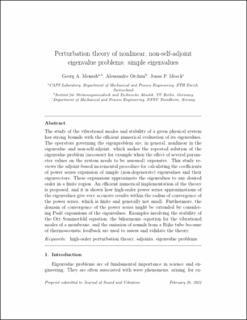| dc.contributor.author | Mensah, Georg | |
| dc.contributor.author | Orchini, Alessandro | |
| dc.contributor.author | Moeck, Jonas | |
| dc.date.accessioned | 2021-03-24T08:45:10Z | |
| dc.date.available | 2021-03-24T08:45:10Z | |
| dc.date.created | 2020-01-31T15:55:05Z | |
| dc.date.issued | 2020 | |
| dc.identifier.citation | Journal of Sound and Vibration. 2020, 473 1-18. | en_US |
| dc.identifier.issn | 0022-460X | |
| dc.identifier.uri | https://hdl.handle.net/11250/2735208 | |
| dc.description.abstract | The study of the vibrational modes and stability of a given physical system is strongly tied to the efficient numerical evaluation of its eigenvalues. The operators governing the eigenproblem are, in general, nonlinear in the eigenvalue and non-self-adjoint, which makes the repeated solution of the eigenvalue problem (necessary, for example, when the effect of several parameter values on the system needs to be assessed) expensive. This study reviews the adjoint-based incremental procedure for calculating the coefficients of power series expansions of simple (non-degenerate) eigenvalues and their eigenvectors. These expansions approximate the eigenvalues to any desired order in a finite region. An efficient numerical implementation of the theory is proposed, and it is shown how high-order power series approximations of the eigenvalues give very accurate results within the radius of convergence of the power series, which is finite and generally not small. Furthermore, the domain of convergence of the power series might be extended by considering Padé expansions of the eigenvalues. Examples involving the stability of the Orr–Sommerfeld equation, the biharmonic equation for the vibrational modes of a membrane, and the emission of sound from a Rijke tube, associated with thermoacoustic feedback, are used to assess and validate the theory. | en_US |
| dc.language.iso | eng | en_US |
| dc.publisher | Elsevier | en_US |
| dc.rights | Attribution-NonCommercial-NoDerivatives 4.0 Internasjonal | * |
| dc.rights.uri | http://creativecommons.org/licenses/by-nc-nd/4.0/deed.no | * |
| dc.title | Perturbation theory of nonlinear, non-self-adjoint eigenvalue problems: Simple eigenvalues | en_US |
| dc.type | Peer reviewed | en_US |
| dc.type | Journal article | en_US |
| dc.description.version | acceptedVersion | en_US |
| dc.source.pagenumber | 1-18 | en_US |
| dc.source.volume | 473 | en_US |
| dc.source.journal | Journal of Sound and Vibration | en_US |
| dc.identifier.doi | 10.1016/j.jsv.2020.115200 | |
| dc.identifier.cristin | 1788715 | |
| dc.description.localcode | "© 2020. This is the authors’ accepted and refereed manuscript to the article. Locked until 21.1.2022 due to copyright restrictions. This manuscript version is made available under the CC-BY-NC-ND 4.0 license http://creativecommons.org/licenses/by-nc-nd/4.0/ " | en_US |
| cristin.ispublished | true | |
| cristin.fulltext | postprint | |
| cristin.qualitycode | 2 | |

